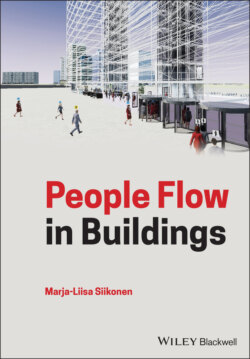Читать книгу People Flow in Buildings - Marja-Liisa Siikonen - Страница 34
3 Passenger Arrival Process in Buildings 3.1 Introduction
ОглавлениеThe passenger arrival process, i.e. the passenger inter‐arrival times when arriving in the elevator lobbies, is reviewed in this chapter. The difference between uniform, Poisson and compound batch Poisson arrivals is shown in Figure 3.1 where the arrival rate is five persons in five minutes (Siikonen 2016). In uniform arrivals, passenger inter‐arrival time is constant. In the Poisson process, passengers arrive randomly in the lobbies and their inter‐arrival times vary. Over a longer time period, here 15 minutes, the arrival rate can stay constant. The third example shows passengers moving in small groups, i.e. batches. The inter‐arrival times of passenger batches are random and exponentially distributed.
Figure 3.1 Passenger inter‐arrival times in elevator lobbies.
Table 3.1 X 2 ‐test results for passenger entering through the security gates, office in Warsaw.
| Time of day | Arrival interval (s) | X 2 | Degrees of freedom | X 2 0.95 | X 2 0.05 | Suitability of H0‐hypothesis |
|---|---|---|---|---|---|---|
| Daily 7:00–19:00 | 10 | 2241 | 7 | 2.2 | 14.1 | Poor |
| 30 | 1632 | 11 | 4.6 | 19.7 | Poor | |
| 60 | 3120 | 11 | 4.6 | 19.7 | Poor | |
| 300 | 548 | 15 | 7.3 | 25.0 | Poor | |
| 8:00–9:00 | 10 | 63 | 10 | 3.9 | 18.3 | Poor |
| 30 | 250 | 15 | 7.3 | 25.0 | Poor | |
| 60 | 12.6 | 14 | 6.6 | 23.7 | Good | |
| 300 | 208 | 15 | 7.3 | 25.0 | Poor | |
| 17:00–18:00 | 10 | 9.9 | 3 | 0.4 | 7.8 | Poor |
| 30 | 4.3 | 4 | 0.7 | 9.5 | Good | |
| 60 | 9.4 | 6 | 1.6 | 12.6 | Good | |
| 300 | 9.5 | 13 | 5.9 | 22.4 | Good |
Social behaviour affects the passenger arrival process. The arrival process can be observed manually on the entrance floors, but the data security gates also give the arrival rate information. Passenger trip from origin to destination floor is random but follows building population distribution on each floor and the utilization of floors, and it varies according to the traffic pattern at different times of day. Statistics of traffic patterns during the day can be measured automatically by elevator control systems or external devices where passengers are counted using the methods described in Chapter 2. Individual passenger journeys from the origin floor to the destination can be followed by the destination or access control system, or other ID‐based systems. From the measured origin–destination data, forecasts can be made to improve passenger service.
Alexandris (1977) suggested that passenger arrivals in buildings follow Poisson process, i.e. passengers are assumed to arrive randomly in the elevator lobbies. The observations of Kuusinen in an office building revealed that people arrive randomly in up‐peak situation in offices but not during lunch time (Kuusinen 2008), when people tend to move in social groups, here called batches. This study was extended to cover different types of buildings. The smallest batch size is naturally one person. The observed batch sizes were the smallest in offices, and the biggest in resort hotels where the average batch size during the day was nearly two persons. The conclusion was that the arrivals of batches follow a Poisson process and thus the passenger arrivals can be modelled by a compound Poisson process. This is important to understand when generating realistic passenger traffic for simulations. In batches, usually one person only gives an elevator call, which makes a difference especially in destination control where all passengers are assumed to give a call.
